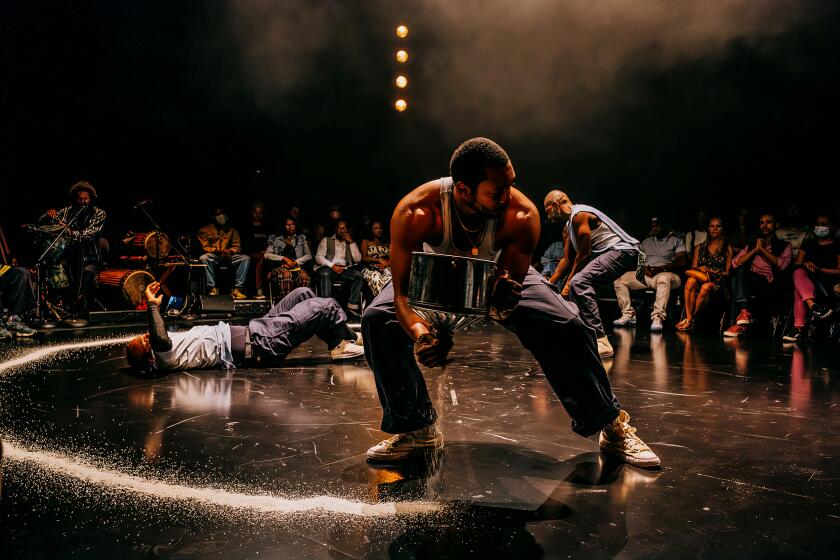South From Mexico
For 70 years, the portrait of a bricklayer by one of Mexico’s premier artists, Diego Rivera, gathered dust, hanging undisturbed and unrecognized behind a bedroom door in the home of a prominent local family.
Last weekend, restored to its original vigor, the canvas--titled “El Albanil”--took its place among other prized works representing 3,000 years of Latin American artistic endeavor in a new $11-million wing of the San Antonio Museum of Art named for a legendary business and political figure who was a lifelong avid collector of Mexican folk art.
The Nelson A. Rockefeller Center for Latin American Art houses 10,000 artworks, encompassing four specialized areas within its three-story, 30,000 square feet--an extensive folk art collection, pre-Columbian artifacts, Spanish Colonial works and contemporary art.
“Other museums have more extensive individual collections,” said Marion Oettinger, curator of Latin American art at the museum, “but this is certainly the most comprehensive in the United States.”
The history of the “lost” Rivera painting serves as a metaphor for much of the art of Latin America, especially folk art, which had been neglected by scholars in the United States until recently.
The family that owned the Rivera, which has asked to remain anonymous, had been told the work was not authentic, in part because Rivera’s signature differed from his later works. So it remained behind the door.
Oettinger said the artwork “looked as though it had been run through a Cuisinart.”
Fortunately, a recent examination by experts concluded that the work was indeed authentic, painted by the 18-year-old Rivera in 1904 while he was attending Mexico City’s famed Bellas Artes national academy. The mason came to the school as a model for a student competition, Oettinger said, a competition Rivera won. Rivera’s signature matched his handwriting of that time period, and a pamphlet from that era mentioned the painting and Rivera.
A painstaking restoration followed, and the family has loaned the Rivera to the museum. Now, Oettinger is planning to hold the center’s first international symposium early next year, introducing the work to scholars.
There is a sublime bit of irony in a Rivera painting being the centerpiece of the opening exhibition in the Rockefeller wing. In the early 1930s, Rivera was commissioned to execute a mural in the lobby of the RCA building in Manhattan as part of Rockefeller Center. But after beginning work on the fresco, Rivera strayed from the drawings he had submitted and included an image of Lenin opposite a group of high society types playing bridge.
It was Nelson Rockefeller--likely acting at the behest of his father, John D. Rockefeller Jr., and the managers of the Rockefeller Center development--who initially asked Rivera to amend the mural. The artist refused and after months of negotiation, including an effort by Nelson Rockefeller to have the unfinished fresco moved to the Museum of Modern Art, the mural was destroyed.
Nelson Rockefeller’s love of Mexican folk art, in particular, endured throughout his life. His guides into this world early on were painter Roberto Montenegro and writer-caricaturist Miguel Covarrubias. Rockefeller’s last collecting trip to Mexico occurred only months before his death in 1978. Rockefeller’s belief that the values and character of a people are reflected in utilitarian folk art was a fascinating counterpoint to his usual haunts, the corridors of international power. But it also reflected his belief as an internationalist that the first world must take responsibility for developing economies and eliminating poverty in the Third World. In addition to holding various government posts, Rockefeller established two private international development agencies after World War II to help the people of Latin America.
The Rockefeller Center is directing the art world’s attention on this city, which is attempting to build on the interest spurred in 1991, when the San Antonio Museum of Art became one of only three museums in the United States, along with Los Angeles County Museum of Art and the Metropolitan Museum of Art in New York, to present “Mexico: Splendors of Thirty Centuries.”
The San Antonio museum’s architecture is uniquely suited to this city, known for its dedication to historic preservation. Opened in 1981, the museum is housed in what was once a brick brewery, built in 1884, and is located on the banks of the San Antonio River, north of the city’s popular commercial River Walk. The city plans to extend the river’s commercial sector to reach the museum in the future.
Six members of the Rockefeller family attended the festive opening ceremonies, including New York Lt. Gov. Winthrop Rockefeller, Nelson A. Rockefeller Jr., and were led by Ann Rockefeller Roberts, who made a gift of her father’s 2,500-piece folk art collection to the San Antonio Museum of Art in 1985.
Nelson Rockefeller Jr. praised the center for reflecting his father’s vision of the function of everyday art, which “encourages understanding, which leads to respect, which leads to peace, which leads to prosperity.”
As with Rockefeller, collecting folk art has been a labor of love for curator Oettinger. For the past 15 years, he has traveled extensively to the small Mexican villages where he often procures folk art pieces made by the children and grandchildren of artisans Rockefeller encountered in his foraging.
The folk art presentation is extensive, featuring utilitarian objects, ceremonial and decorative art, ranging from textiles, pottery, saddles and Day of the Dead tableaux. One gallery features profiles of the families of artisans who have produced the works, often for generations. The museum’s folk art holdings make up half of the works in its Latin American collections. In addition to the Rockefeller works, the folk art galleries in the new center display works donated by other collectors, most notably Robert Winn, who gave the museum 3,000 works.
The Pre-Columbian art galleries feature funereal pieces from the Olmec, Maya and Aztec civilizations, among them the prized 43-piece Elizabeth Huth Coates collection that includes a Mixtec turquoise mask and a brilliant gold crown from what is now Peru.
Spanish Colonial art is displayed in a room with an arched, barrel-vault ceiling, and includes liturgical silver, religious statues and furniture, and more than 200 paintings, including works by Juan Correa and the haunting death portraits of children known as “angelitos.”
The 20th century art collection focuses on Mexican artists, including Rivera, Frida Kahlo and Rufino Tamayo.
“This is a tremendous collection,” said Avon Neal, a New York author and friend of Rockefeller, who attended the opening ceremonies. “Nelson had such a good eye. He was so sensitive to the spirit within utilitarian implements.”
In keeping with Rockefeller’s belief in the power of art to promote peace and understanding, the center is more than an exhibition hall. An orientation gallery features interactive computer programs and maps of the regions of Latin America. Schoolchildren will participate in art classes.
To illustrate that belief, a group of students from a local elementary school presented a painting of the Aztec calendar to Ann Rockefeller Roberts, who spoke of “opening the door” not just to the center, but to a dream of understanding.
“This dream comes not just from my father,” she said, “but from our countries, from North America and South America.”
More to Read
The biggest entertainment stories
Get our big stories about Hollywood, film, television, music, arts, culture and more right in your inbox as soon as they publish.
You may occasionally receive promotional content from the Los Angeles Times.






